Many flower enthusiasts encounter the problem of phalaenopsis petals flipping backward suddenly during maintenance. In fact, this phenomenon is mostly caused by improper maintenance environment or natural growth laws. The following details the causes and solutions:
一、Causes
High Temperature
When the environmental temperature remains above 30°C, water in the petals evaporates rapidly, causing dehydration, deformation, and backward curling.
Excessive Sunlight
Phalaenopsis prefers diffused light. Prolonged direct sunlight damages petal cells, leading to backward flipping.
Low Humidity
When air humidity is below 50%, petals become fragile due to water shortage, resulting in curling and backward flipping.
Root Rot
Prolonged dampness or waterlogging in the pot soil causes root rot, preventing normal water absorption. Petals deform as they "fail to absorb water."
Nutrient Deficiency
Lack of phosphorus and potassium fertilizers before the flowering period weakens petal growth, reducing their support and making them prone to flipping backward.
Natural Aging
In some phalaenopsis varieties, petals naturally flip backward and droop at the end of the flowering period—a normal physiological phenomenon indicating the flowers are about to wither.
二、Solutions
Light & Temperature
Move the phalaenopsis to a well-ventilated area with diffused light (e.g., near a window with a sheer curtain).
Maintain the temperature at 16–28°C and avoid direct air conditioning drafts.
Humidity Control
Spray water around the plant daily, place a water tray, or use a humidifier to raise air humidity to 60%–80%.
Watering
Adopt the "dry-wet cycle" method: water thoroughly when the top 2–3 cm of soil dries out, avoiding waterlogging.
Fertilization
Before flowering, spray or water with "Huaduoduo No. 2" (diluted 1000 times) monthly to enhance petal toughness.
Emergency Adjustment
For slightly flipped petals, gently press them backward with fingers in the morning (when petals are soft), acting with care to avoid tearing.
Pruning
For severely flipped flowers that cannot recover, cut them from the flower stem 1.5 cm above the base to reduce nutrient consumption and allow the plant to focus on new buds.
Prevention
Regularly check soil moisture, adjust light and humidity, especially in high-temperature and dry seasons, to minimize the probability of petal flipping.
In short, mastering these methods will ensure your phalaenopsis blooms beautifully next time!
What Causes Phalaenopsis Petals to Flip Backward?

Share with
Tagged in :




Leave a Reply